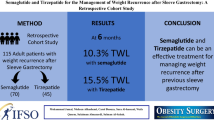Abstract
The aim of this study was to review the outcome of acromegaly treatment, as well as co-morbidity and mortality in a series of patients with acromegaly attending a single center in the last 10 yr. In that period, 53 patients were treated for acromegaly. Transsphenoidal operation was applied as the first-line therapy in 94.3% of patients and it led to disease remission in 59.2% of them. The remission criteria included a nadir GH<1 µg/l after glucose load, and normal age-related IGF-I levels. The remission rate after transsphenoidal surgery was significantly higher in the group of patients with microadenoma (76.9%), than in the group of patients with macroadenoma (52.8%). Patients with invasive tumors had remission rate of 16.7% after transsphenoidal surgery. There were no perioperative deaths. As the second-line treatment somatostatin analogues, radiotherapy, and dopaminergic agonists were used. Hypertension and diabetes were the most frequent co-morbidities in the group of patients. After successful treatment, 30% of patients with diabetes or impaired glucose tolerance had significant improvement of glycemic control. Transsphenoidal surgery is the appropriate first-line therapy in patients with somatotropinoma. Medical and radio-therapy should be reserved as the second-line therapy after surgery failure.
Similar content being viewed by others
References
Holdaway IM, Rajasoorya C. Epidemiology of acromegaly. Pituitary 1999, 2: 29–41.
Colao A, Auriemma RS, Pivonello R, Galdiero M, Lombardi G. Medical consequences of acromegaly: what are the effects of biochemical control? Rev Endocr Metab Disord 2008, 9: 21–31.
Holdaway IM, Bolland MJ, Gamble GD. A meta-analysis of the effect of lowering serum levels of GH and IGF-I on mortality in acromegaly. Eur J Endocrinol 2008, 159: 89–95.
Melmed S, Colao A, Barkan A, et al; Acromegaly Consensus Group. Guidelines for acromegaly management: an update. Clin Endocrinol Metab 2009, 94: 1509–17.
Giustina A, Chanson P, Bronstein MD, et al; Acromegaly Consensus Group. A consensus on criteria for cure of acromegaly. J Clin Endocrinol Metab 2010, 95: 3141–8.
Kreutzer J, Vance ML, Lopes MB, Laws ER Jr. Surgical management of GH-secreting pituitary adenomas: an outcome study using modern remission criteria. Clin Endocrinol Metab 2001, 86: 4072–7.
Gittoes NJ, Sheppard MC, Johnson AP, Stewart PM. Outcome of surgery for acromegaly — the experience of a dedicated pituitary surgeon. QJM 1999, 92: 741–5.
Swearingen B, Barker FG 2nd, Katznelson L, et al. Long-term mortality after transsphenoidal surgery and adjunctive therapy for acromegaly. Clin Endocrinol Metab 1998, 83: 3419–26.
De P, Rees DA, Davies N, et al. Transsphenoidal surgery for acromegaly in Wales: results based on stringent criteria of remission. Clin Endocrinol Metab 2003, 88: 3567–72.
Attanasio R, Montini M, Valota M, et al. An audit of treatment outcome in acromegalic patients attending our center at Bergamo, Italy. Pituitary 2008, 11: 1–11.
Mestron A, Webb SM, Astorga R, et al. Epidemiology, clinical characteristics, outcome, morbidity and mortality in acromegaly based on the Spanish Acromegaly Registry (Registro Espanol de Acromegalia, REA). Eur J Endocrinol 2004, 151: 439–46.
Nomikos P, Buchfelder M, Fahlbusch R. The outcome of surgery in 668 patients with acromegaly using current criteria of biochemical ‘cure’. Eur J Endocrinol 2005, 152: 379–87.
Bex M, Abs R, T’Sjoen G, et al. AcroBel-the Belgian registry on acromegaly: a survey of the ‘real-life’ outcome in 418 acromegalic subjects. Eur J Endocrinol 2007, 157: 399–409.
Biermasz NR, Dekker FW, Pereira AM, et al. Determinants of survival in treated acromegaly in a single center: predictive value of serial insulin-like growth factor I measurements. J Clin Endocrinol Metab 2004, 89: 2789–96.
Abosch A, Tyrrell JB, Lamborn KR, Hannegan LT, Applebury CB, Wilson CB. Transsphenoidal microsurgery for growth hormone-secreting pituitary adenomas: initial outcome and long-term results. J Clin Endocrinol Metab 1998, 83: 3411–8.
Kreutzer J, Vance ML, Lopes MB, Laws ER Jr. Surgical management of GH-secreting pituitary adenomas: an outcome study using modern remission criteria. J Clin Endocrinol Metab 2001, 86: 4072–7.
Fukuda I, Hizuka N, Murakami Y, et al. Clinical features and therapeutic outcomes of 65 patients with acromegaly at Tokyo Women’s Medical University. Intern Med 2001, 40: 987–92.
Murray RD, Peacey SR, Rahim A, Toogood AA, Thorner MO, Shalet SM. The diagnosis of growth hormone deficiency (GHD) in successfully treated acromegalic patients. Clin Endocrinol (Oxf) 2001, 54: 37–44.
de Boer H, Roelfsema F, Frölich M, Kamphuisen HA, van Seters AP. Plasma growth hormone profiles and sleep: a study of 13 treated acromegalics. Clinical Endocrinology 1989, 30: 251–61.
Colao A, Ferone D, Marzullo P, Lombardi G. Systemic complications of acromegaly: epidemiology, pathogenesis, and management. Endocr Rev 2004, 25: 102–52.
Reid TJ, Post KD, Bruce JN, Nabi Kanibir M, Reyes-Vidal CM, Freda PU. Features at diagnosis of 324 patients with acromegaly did not change from 1981 to 2006: acromegaly remains under-recognized and under-diagnosed. Clin Endocrinol (Oxf) 2010, 72: 203–8.
Melmed S. Acromegaly. N Engl J Med 2006, 355: 2558–73.
Author information
Authors and Affiliations
Corresponding author
Rights and permissions
About this article
Cite this article
Dusek, T., Kastelan, D., Melada, A. et al. Clinical features and therapeutic outcomes of patients with acromegaly: Single-center experience. J Endocrinol Invest 34, e382–e385 (2011). https://doi.org/10.3275/7858
Accepted:
Published:
Issue Date:
DOI: https://doi.org/10.3275/7858



